What a Way to Go — 1950’s Style
Thread Starter
What a Way to Go — 1950’s Style
By Troopship to the Far East
If in the 1950’s you were posted abroad, there was a good chance that you’d be conveyed to your destination by troopship. With world-wide commitments and large numbers of troops based in many parts of the world, the most economical method of getting lots of servicemen to where they were wanted was by troopship. Which is what happed to me in the mid-1950’s when I was conveyed to and from the Far East by the British India Steam Navigation troopship the SS Nevasa.
A little research shows that the Nevasa that was built in 1956 as a troopship to government specifications and despite being operated by the British India Steam Navigation line she sported a buff coloured funnel rather than the normal B.I. black funnel with two white bands.
The Nevasa had a tonnage of 20,527 tons with accommodation for 220 1st class pax, 110 2nd class, 180 3rd class and 1,000 troops on the troop decks.
A similar troopship, the SS Oxfordshire was also in service at this time operated by the Bibby Line.
My journey to the Far East in October 1956 was only the Nevasa’s second voyage; her maiden voyage had been to Malta. Nevasa served as a troopship from 1956 to 1962, but as National Service came to an end in the early 1960s and air transport became more efficient, troopships were made redundant, the last troopship voyage being made in December 1962 by the SS Oxfordshire to Malta. OK the Uganda and QE II were used in the Falklands campaign, but they weren’t designed as troopships.
In 1956 I was with Fighter Command Communications Squadron based at RAF Bovingdon near Hemel Hempstead in Hertfordshire. In July 1956 I received the standard PWR (Preliminary Warning Role) letter notifying me that I had been selected for posting to the Far East Air Force (FEAF) and that I was to report to number 5PDU at RAF Innsworth in Gloucestershire to be kitted out for my posting. Departure date from Southampton was scheduled for 19th of August 1956 on the SS Nevasa. In the event, with the Suez crisis in full swing and the closure of the Suez Canal the planned sailing date was postponed to an undecided future date. With the Canal closed we were told that we would be travelling on the ‘long’ route around the Cape of Good Hope and we were to remain at RAF Innsworth pending a new departure date.

My record of service showing the 'blip' in my posting to the Far East.
Having been kitted out with tropical kit and received our overseas jabs we hung around Innsworth for about two weeks, but with no departure date set for the voyage we were sent home on leave for about six weeks, being told that once a firm departure date had been decided we’d receive a letter or telegram advising us when we had to return to Innsworth.
With six weeks advance pay jangling in my pocket I went home.
Six weeks of absolutely nothing to do on paid leave at home was quite splendid, I saw my girlfriend again — we’d already said our tearful farewells and here I was back again! So we went dancing and had a week by the sea at Clacton. Whilst at Clacton I was amazed at the constant procession along the main roads of convoys of army vehicles towing guns, all with newly applied sand-coloured desert camouflage as they proceeded to east coast ports for loading on vessels to be transported to the Middle East.
Rather enjoying life I spent a further few weeks saying further prolonged farewells to all my family and friends and had a rather good time at the taxpayer’s expense! The call-forward letter eventually arrived and I returned to Innsworth, the R.A.F. draft for the Far East was bussed down to Southampton where we embarked on the British India troopship ‘Nevasa’ — we sailed on the 16th of October 1956.
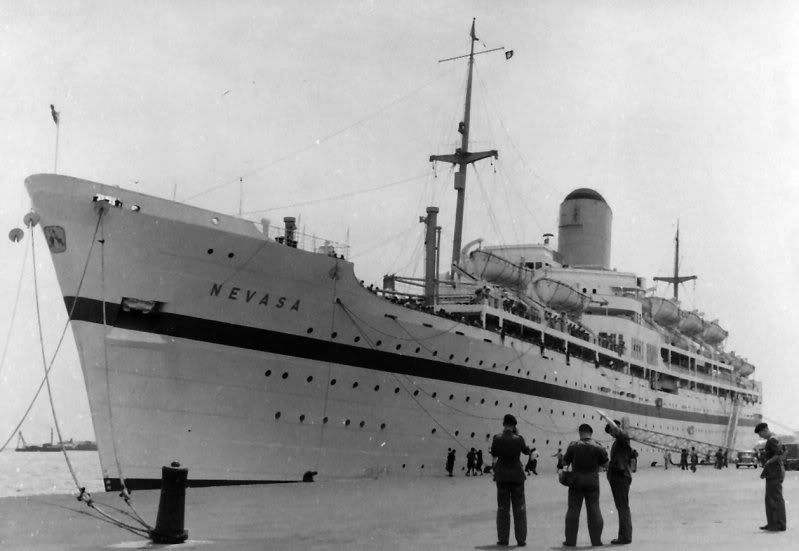
Nevasa at Southampton Docks - Oct 1956
Five years earlier in 1951, as a newly conscripted RAF recruit I was posted to the then Southern Rhodesia for service with 5 FTS (R.A.F. Thornhill) in the Rhodesian Air Training Group, the journey in those days being by sea as Cabin Class passengers on Union Castle Line liners from Southampton to Cape Town. Having already travelled by sea, albeit on an ocean liner (the RMS “Edinburgh Castle”) as a Cabin Class passenger, I had vague hopes that the Nevasa, reputably a modern troopship, would provide similar standards of comfort; sadly for us lower ranks the opposite was true, the voyage turned out to be one of the most uncomfortable and boring journeys I’ve ever made. Joining the Nevasa at Southampton the rumour was that because of the closure of the Suez Canal the Nevasa would be carrying up to twice the normal number of service personnel, in retrospect probably an exaggeration, but we were certainly carrying far more than the designed complement of troops. It was obvious when we embarked that the journey was not going to be anything like my fondly remembered comfortable passenger liner voyage. The bunks in the troop decks, normally three tiers high, had been rearranged by squeezing in an additional tier making four in all which meant that the space was so cramped that if one wanted to turn round in the bunk it could only be done by climbing out of the bunk and getting back in again.
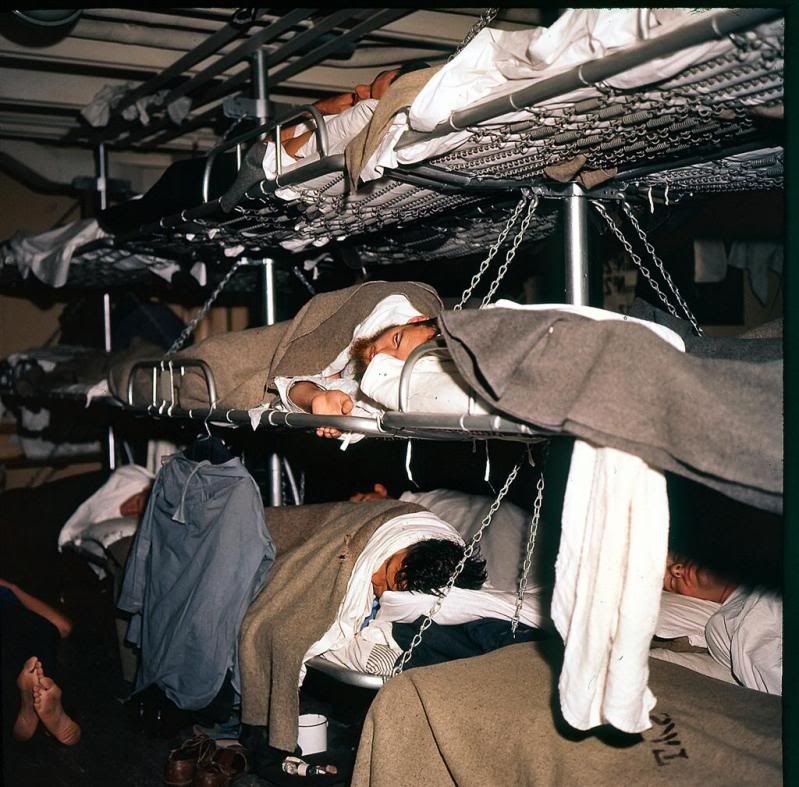
This picture of the bunks on the troop deck was taken two year's later and shows standard 3-tier layout. On the way out in 1956 an extra tier had been added.
On our troop deck near the bow, the toilets were designed for about half the number of men being carried and a queue regularly formed to use them. Both showers and wash basins were fed by salt water, and the so called “salt-water” soap that we were given was a joke; there was just no way one could raise a lather with it to make oneself clean. There was one water fountain fed by fresh water which we used to clean our teeth.
During the voyage we ran into two quite severe storms, the first as we left Southampton lasted for about three days as we passed through the Bay of Biscay; the second was off the west coast of Africa in the South Atlantic. For most troops on board the first storm was a major upset, and nearly all were violently seasick. The packed bunks meant those on the bottom tiers were regularly regurgitated on by those above which was most unpleasant, one poor soul never really gained his sea-legs and was sick for most of the one-month long voyage. My memory of the food on board is that it was reasonable but not anything to really write home about; with so many to cater for the meals had to be taken in three separate half-hour sittings.

The outdoor deck screen
Apart from the occasional film, entertainment was virtually non-existent, when we reached the tropics films were shown on the open foredeck but with no seats we sat crossed-legged on the wooden deck and made our self as comfortable as possible. Being in the open the occasional tropical shower would terminate the performance, a memorable experience for all the wrong reasons!
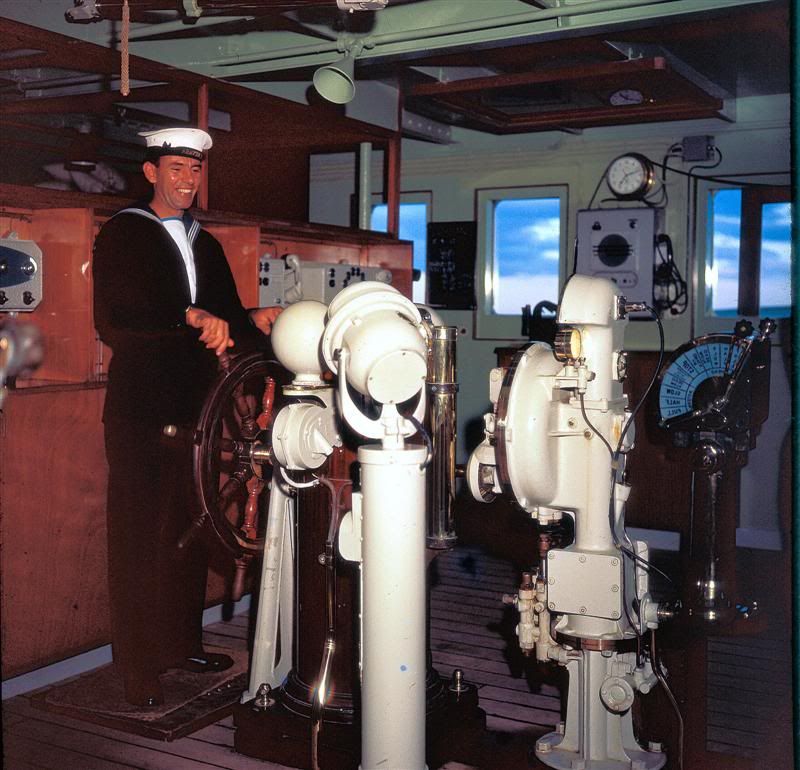
We were invited to visit the bridge and couln't resist taunting the helmsman with 'The Navy Lark' catch phrase "Left hand down a bit!"
During the day we were required to do physical exercise on deck, with the army drill instructor shouting at us if we weren’t up to his ideal of physical perfection. Deck games were organised with team competitions between the various services and we also were taken to the rear of the ship and given a .303 rifle and invited to shoot at balloons that had been thrown into the water for target practice.
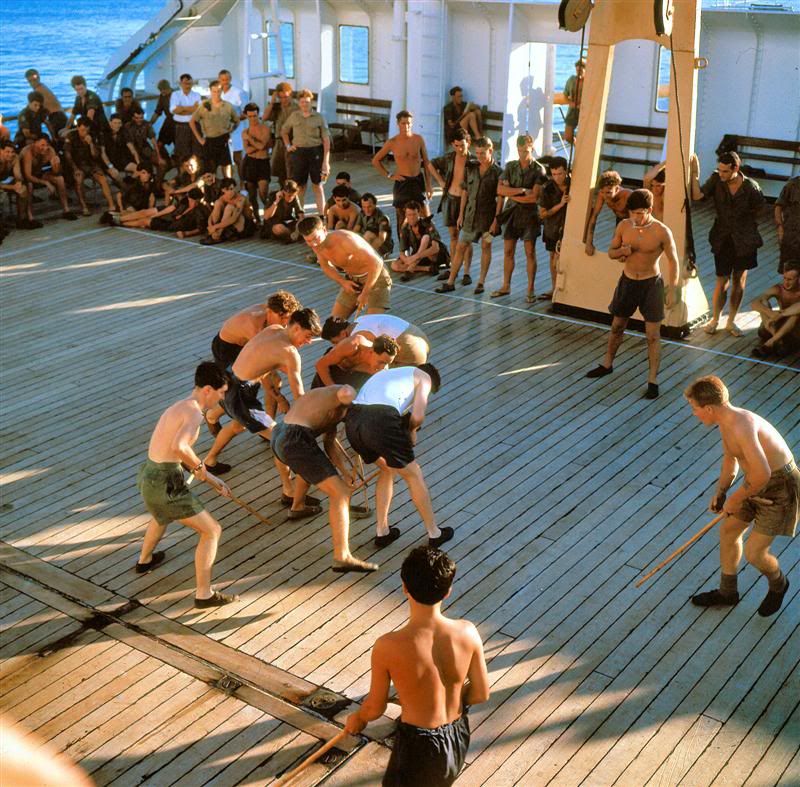
Inter Service Deck Games.
With the Suez Canal closed the long round the Cape route to the Far East meant stops in unfamiliar ports. We had a very short stop at Las Palmas in the Canary Islands to take on food and provisions; we were allowed to stretch our legs on the quayside but were forbidden from going into town. The next stop was Dakar in Senegal, at the time a French colony, civilised and a nice place to unwind, although we were only allowed ashore during the day.
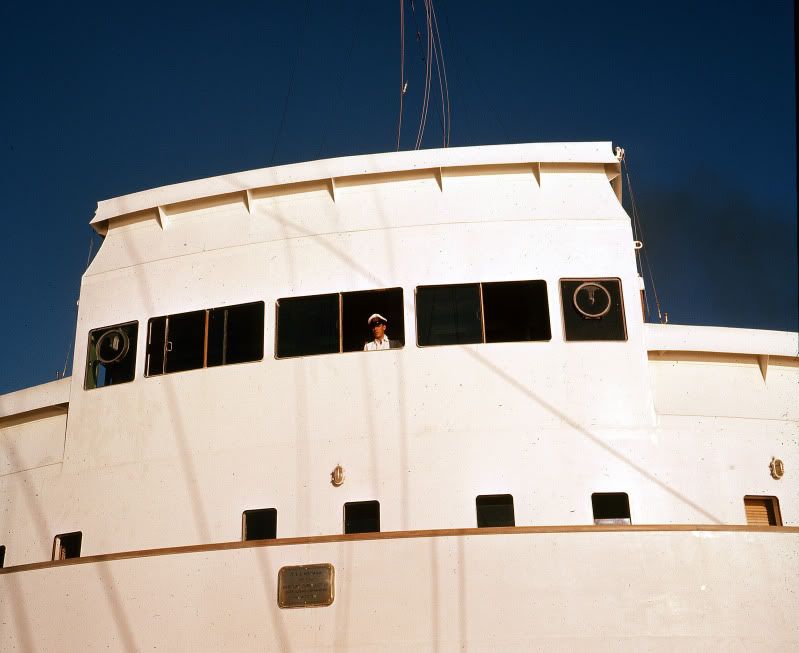
Nevasa - The Bridge
Dakar allowed me to stock up with some Ektachrome colour 120 film for my reflex camera, which in 1956 was virtually unobtainable in the UK without a special licence.

This photo was taken somewere south of Dakar with my newly acquired colour film and shows how white we all were as we tried to get our knees brown!
Having left Dakar our next stop was Durban in South Africa. Between Dakar and Durban the ship’s supply of beer ran out, which was pretty disastrous. Sailing down the west coast of Africa towards the Cape, we ran into a severe South Atlantic storm, so much is so that the boat’s hull was regularly lifted out of the water and came down with an enormous great crash which reverberated throughout the ship, being in the bow we experienced it the most, this weather lasted for about three days. Having rounded the Cape and heading north along the east coast of South Africa towards Durban the weather abated, and we enjoyed a quieter couple of days.

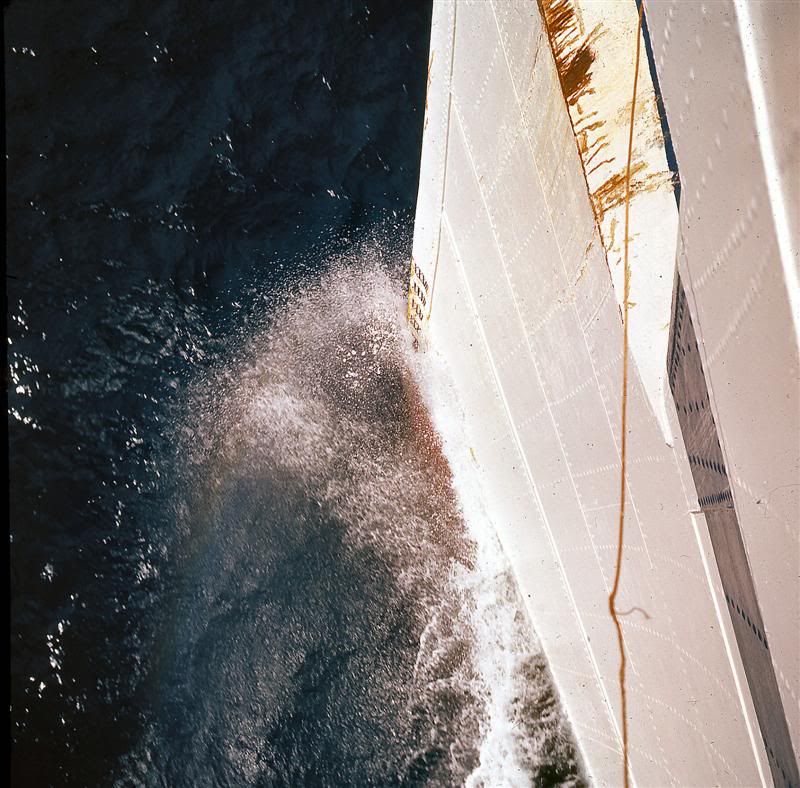
At Durban, we were allowed ashore for the day and evening, with orders to be back on board by midnight. I spent the day sightseeing, swam and tried surfing in the Indian Ocean and in the evening visited the Durban branch of the Royal Air Force Association which was situated in a posh area of town. The RAFA locals were so generous I don’t think any of the RAF servicemen who went for a drink at their club that evening had to pay for anything.
We departed Durban early the next morning and as we passed slowly out of the harbour towards the sea we were greeted by Mrs. Perla Gibson the ‘lady in white’, standing at the end of the northern breakwater and singing through her megaphone and waving to us, we could still see her waving, long after the sound of her voice had faded. The ‘lady in white’ was a wartime legend who sang to the troops as they left harbour on their journey to the battlefields of the Middle and Far East. When we arrived in Durban in 1956, the war had been over for 11 years, but still this lady knew we were coming and sang to us farewell greetings to speed us on our way.
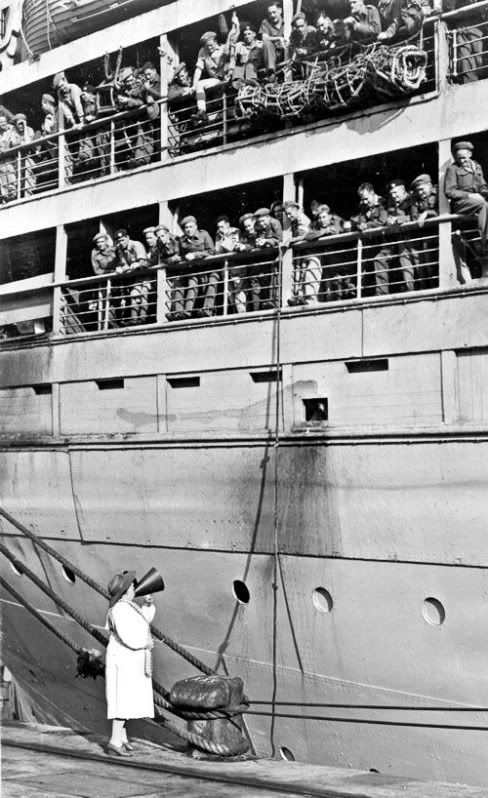
The Lady in White - War Time Photo
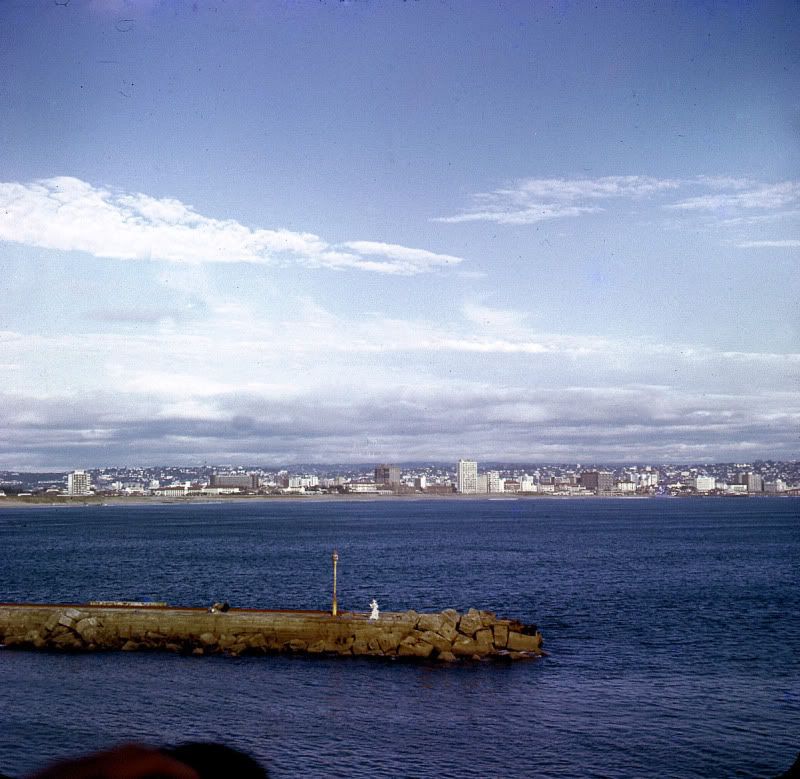
The Lady in White on the North Pier Durban October 1956
Leaving Durban, we headed northeast across the Indian Ocean towards the northern tip of Sumatra, passing the French island of Reunion on the way. Going around the northern trip of Sumatra we were astonished to see enormous numbers of sea snakes swimming in the sea. Eventually, about twelve-days later on 15th of November 1956 the Nevasa dropped anchor at Singapore. Pax for Singapore, Malaya and Ceylon disembarked and the Nevasa continued her voyage onwards to Hong Kong and Korea.

I spent a week at RAF Changi waiting for a flight to my FEAF posting at RAF Negombo in Ceylon and whilst in Singapore took this photo on the Esplanade.
More to come
If in the 1950’s you were posted abroad, there was a good chance that you’d be conveyed to your destination by troopship. With world-wide commitments and large numbers of troops based in many parts of the world, the most economical method of getting lots of servicemen to where they were wanted was by troopship. Which is what happed to me in the mid-1950’s when I was conveyed to and from the Far East by the British India Steam Navigation troopship the SS Nevasa.
A little research shows that the Nevasa that was built in 1956 as a troopship to government specifications and despite being operated by the British India Steam Navigation line she sported a buff coloured funnel rather than the normal B.I. black funnel with two white bands.
The Nevasa had a tonnage of 20,527 tons with accommodation for 220 1st class pax, 110 2nd class, 180 3rd class and 1,000 troops on the troop decks.
A similar troopship, the SS Oxfordshire was also in service at this time operated by the Bibby Line.
My journey to the Far East in October 1956 was only the Nevasa’s second voyage; her maiden voyage had been to Malta. Nevasa served as a troopship from 1956 to 1962, but as National Service came to an end in the early 1960s and air transport became more efficient, troopships were made redundant, the last troopship voyage being made in December 1962 by the SS Oxfordshire to Malta. OK the Uganda and QE II were used in the Falklands campaign, but they weren’t designed as troopships.
In 1956 I was with Fighter Command Communications Squadron based at RAF Bovingdon near Hemel Hempstead in Hertfordshire. In July 1956 I received the standard PWR (Preliminary Warning Role) letter notifying me that I had been selected for posting to the Far East Air Force (FEAF) and that I was to report to number 5PDU at RAF Innsworth in Gloucestershire to be kitted out for my posting. Departure date from Southampton was scheduled for 19th of August 1956 on the SS Nevasa. In the event, with the Suez crisis in full swing and the closure of the Suez Canal the planned sailing date was postponed to an undecided future date. With the Canal closed we were told that we would be travelling on the ‘long’ route around the Cape of Good Hope and we were to remain at RAF Innsworth pending a new departure date.

My record of service showing the 'blip' in my posting to the Far East.
Having been kitted out with tropical kit and received our overseas jabs we hung around Innsworth for about two weeks, but with no departure date set for the voyage we were sent home on leave for about six weeks, being told that once a firm departure date had been decided we’d receive a letter or telegram advising us when we had to return to Innsworth.
With six weeks advance pay jangling in my pocket I went home.
Six weeks of absolutely nothing to do on paid leave at home was quite splendid, I saw my girlfriend again — we’d already said our tearful farewells and here I was back again! So we went dancing and had a week by the sea at Clacton. Whilst at Clacton I was amazed at the constant procession along the main roads of convoys of army vehicles towing guns, all with newly applied sand-coloured desert camouflage as they proceeded to east coast ports for loading on vessels to be transported to the Middle East.
Rather enjoying life I spent a further few weeks saying further prolonged farewells to all my family and friends and had a rather good time at the taxpayer’s expense! The call-forward letter eventually arrived and I returned to Innsworth, the R.A.F. draft for the Far East was bussed down to Southampton where we embarked on the British India troopship ‘Nevasa’ — we sailed on the 16th of October 1956.

Nevasa at Southampton Docks - Oct 1956
Five years earlier in 1951, as a newly conscripted RAF recruit I was posted to the then Southern Rhodesia for service with 5 FTS (R.A.F. Thornhill) in the Rhodesian Air Training Group, the journey in those days being by sea as Cabin Class passengers on Union Castle Line liners from Southampton to Cape Town. Having already travelled by sea, albeit on an ocean liner (the RMS “Edinburgh Castle”) as a Cabin Class passenger, I had vague hopes that the Nevasa, reputably a modern troopship, would provide similar standards of comfort; sadly for us lower ranks the opposite was true, the voyage turned out to be one of the most uncomfortable and boring journeys I’ve ever made. Joining the Nevasa at Southampton the rumour was that because of the closure of the Suez Canal the Nevasa would be carrying up to twice the normal number of service personnel, in retrospect probably an exaggeration, but we were certainly carrying far more than the designed complement of troops. It was obvious when we embarked that the journey was not going to be anything like my fondly remembered comfortable passenger liner voyage. The bunks in the troop decks, normally three tiers high, had been rearranged by squeezing in an additional tier making four in all which meant that the space was so cramped that if one wanted to turn round in the bunk it could only be done by climbing out of the bunk and getting back in again.

This picture of the bunks on the troop deck was taken two year's later and shows standard 3-tier layout. On the way out in 1956 an extra tier had been added.
On our troop deck near the bow, the toilets were designed for about half the number of men being carried and a queue regularly formed to use them. Both showers and wash basins were fed by salt water, and the so called “salt-water” soap that we were given was a joke; there was just no way one could raise a lather with it to make oneself clean. There was one water fountain fed by fresh water which we used to clean our teeth.
During the voyage we ran into two quite severe storms, the first as we left Southampton lasted for about three days as we passed through the Bay of Biscay; the second was off the west coast of Africa in the South Atlantic. For most troops on board the first storm was a major upset, and nearly all were violently seasick. The packed bunks meant those on the bottom tiers were regularly regurgitated on by those above which was most unpleasant, one poor soul never really gained his sea-legs and was sick for most of the one-month long voyage. My memory of the food on board is that it was reasonable but not anything to really write home about; with so many to cater for the meals had to be taken in three separate half-hour sittings.

The outdoor deck screen
Apart from the occasional film, entertainment was virtually non-existent, when we reached the tropics films were shown on the open foredeck but with no seats we sat crossed-legged on the wooden deck and made our self as comfortable as possible. Being in the open the occasional tropical shower would terminate the performance, a memorable experience for all the wrong reasons!

We were invited to visit the bridge and couln't resist taunting the helmsman with 'The Navy Lark' catch phrase "Left hand down a bit!"
During the day we were required to do physical exercise on deck, with the army drill instructor shouting at us if we weren’t up to his ideal of physical perfection. Deck games were organised with team competitions between the various services and we also were taken to the rear of the ship and given a .303 rifle and invited to shoot at balloons that had been thrown into the water for target practice.

Inter Service Deck Games.
With the Suez Canal closed the long round the Cape route to the Far East meant stops in unfamiliar ports. We had a very short stop at Las Palmas in the Canary Islands to take on food and provisions; we were allowed to stretch our legs on the quayside but were forbidden from going into town. The next stop was Dakar in Senegal, at the time a French colony, civilised and a nice place to unwind, although we were only allowed ashore during the day.

Nevasa - The Bridge
Dakar allowed me to stock up with some Ektachrome colour 120 film for my reflex camera, which in 1956 was virtually unobtainable in the UK without a special licence.

This photo was taken somewere south of Dakar with my newly acquired colour film and shows how white we all were as we tried to get our knees brown!
Having left Dakar our next stop was Durban in South Africa. Between Dakar and Durban the ship’s supply of beer ran out, which was pretty disastrous. Sailing down the west coast of Africa towards the Cape, we ran into a severe South Atlantic storm, so much is so that the boat’s hull was regularly lifted out of the water and came down with an enormous great crash which reverberated throughout the ship, being in the bow we experienced it the most, this weather lasted for about three days. Having rounded the Cape and heading north along the east coast of South Africa towards Durban the weather abated, and we enjoyed a quieter couple of days.


At Durban, we were allowed ashore for the day and evening, with orders to be back on board by midnight. I spent the day sightseeing, swam and tried surfing in the Indian Ocean and in the evening visited the Durban branch of the Royal Air Force Association which was situated in a posh area of town. The RAFA locals were so generous I don’t think any of the RAF servicemen who went for a drink at their club that evening had to pay for anything.
We departed Durban early the next morning and as we passed slowly out of the harbour towards the sea we were greeted by Mrs. Perla Gibson the ‘lady in white’, standing at the end of the northern breakwater and singing through her megaphone and waving to us, we could still see her waving, long after the sound of her voice had faded. The ‘lady in white’ was a wartime legend who sang to the troops as they left harbour on their journey to the battlefields of the Middle and Far East. When we arrived in Durban in 1956, the war had been over for 11 years, but still this lady knew we were coming and sang to us farewell greetings to speed us on our way.

The Lady in White - War Time Photo

The Lady in White on the North Pier Durban October 1956
Leaving Durban, we headed northeast across the Indian Ocean towards the northern tip of Sumatra, passing the French island of Reunion on the way. Going around the northern trip of Sumatra we were astonished to see enormous numbers of sea snakes swimming in the sea. Eventually, about twelve-days later on 15th of November 1956 the Nevasa dropped anchor at Singapore. Pax for Singapore, Malaya and Ceylon disembarked and the Nevasa continued her voyage onwards to Hong Kong and Korea.

I spent a week at RAF Changi waiting for a flight to my FEAF posting at RAF Negombo in Ceylon and whilst in Singapore took this photo on the Esplanade.
More to come
Last edited by Warmtoast; 24th Jun 2011 at 19:51.
Thread Starter
By Troopship to the Far East - Part 2
Return Journey — November/December 1958
Almost two years later to the day, on the 12th of November 1958 to be exact, I departed from my final FEAF posting (RAF Gan in the Maldive Islands) having earlier during my Far East tour been stationed at Negombo, China Bay, Seletar and finally Gan, I flew from Gan to RAF Katunayake near Colombo in Sri Lanka to join the Nevasa (again!) for my return to the UK.

Tour Ex - The best part of any posting - departing Gan.
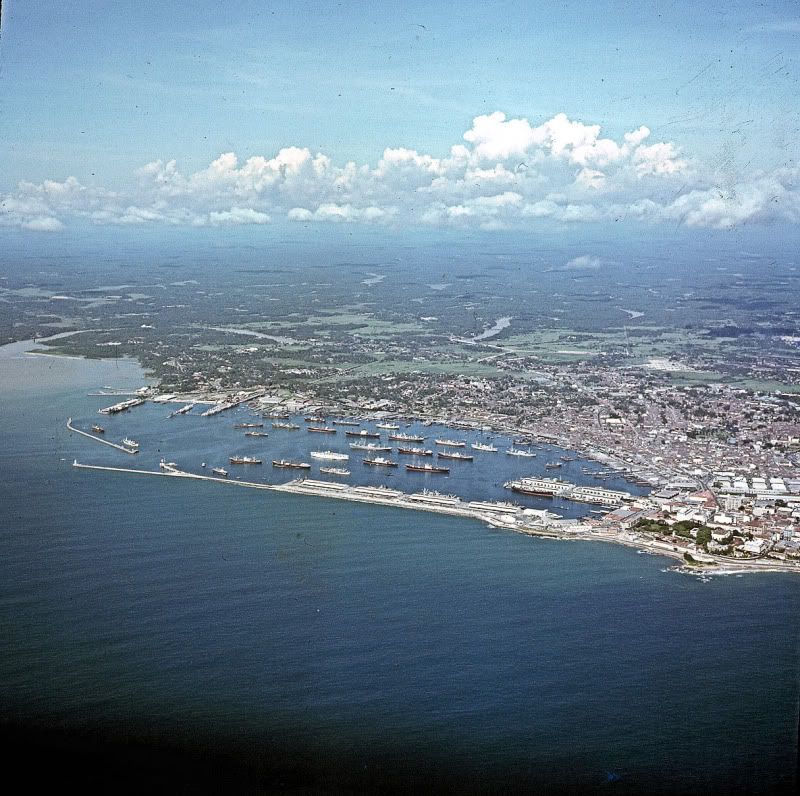
On the way to Katunayake we passed over Colombo harbour. The Nevasa, the large white vessel can be seen at anchor in the harbour.

The next day on the 13th of November 1958 I embarked on the Nevasa for the return voyage to the UK. Here Waiting in Colombo harbour for the ferry to the Nevasa that can be seen in the background.
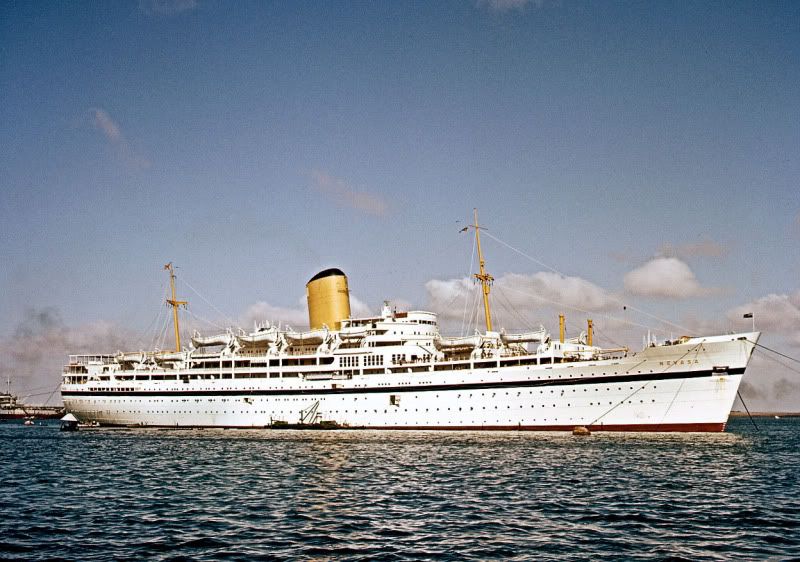
Here's the Nevasa in all her glory.
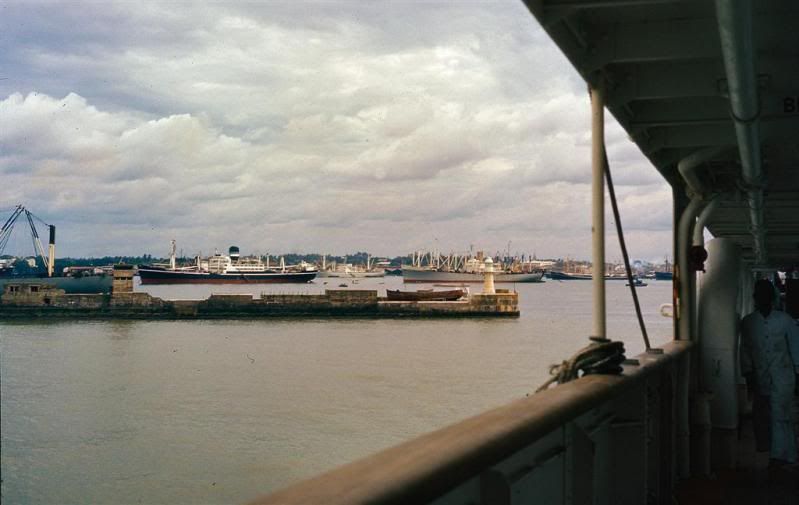
Departing Colombo Harbour en-route to our next stop - Aden.
We called at Aden and had a day ashore for duty-free shopping (I bought one of the newly introduced transistor radios very cheaply).
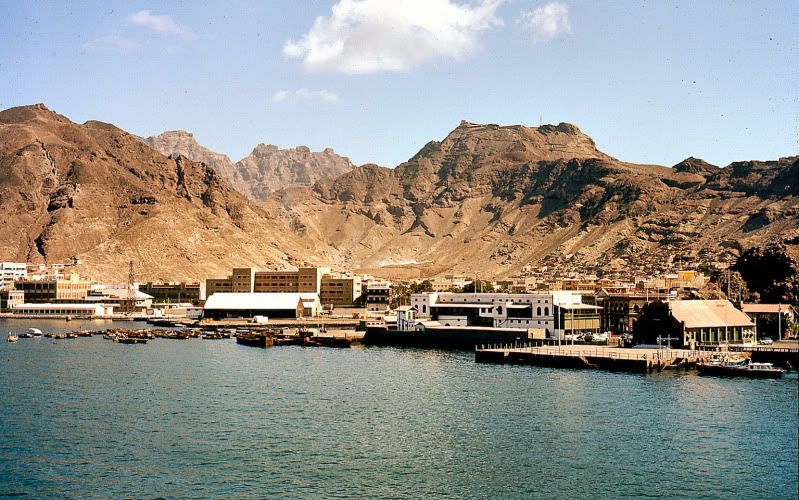
This view of Steamer Point shows the RN shore base at Aden (HMS Sheba) low building extreme left alongside the waterfront with the Crescent Hotel immdiately behind it.

Our passage to Port Suez was easy and calm.
We sailed though the Suez Canal viewing the wrecks of ships sunk during the crisis two years earlier and we dropped anchor at Port Suez for a very short stop. We weren’t allowed ashore here but the bum-boats that swarmed around the ship did a brisk business in Egyptian trinkets and souvenirs. Following this short stop we were on our way again to our next stop in Gibraltar, our final stop on the way home, where we were allowed ashore again.
Some Memories
I have some memories of the trip home; the comfort level of the ship was improved in that the bunks were in tiers of three rather than the four that we endured on the way out. But the rest of the voyage was very similar to the journey out, PT on deck, team games and rifle shooting at balloons, more films in the evenings, most of which we’d all seen months earlier. The dining arrangements were similar to the journey out, but this time only with two sittings for meals rather than three. Thankfully we didn’t run out of beer on the way home, which was a relief.
Noteworthy was the sudden overnight change from the warmth of the Red Sea to the chill of the desert as we travelled north up the Red Sea. With the arrival of the cooler weather we were told to change from our tropical KD uniforms into standard UK uniforms. This caused a few problems as most of us hadn’t worn these for two years or so. Like many, my uniform had been sealed up in a waterproof bag shortly after my arrival in the Far East supposedly to stop it being affected by the high humidity, but in my case something had gone seriously wrong because when opened the uniform had gone mouldy – thankfully there was an Indian tailor among the ship’s crew who knew exactly how to deal with this problem (from experience perhaps?) and he passed it back to me, minus the mould, but stinking to high heaven — this musty odour remained with me for the rest of the voyage!
With my newly acquired transistor radio to play with as we travelled north up the Red Sea we searched the wave-bands for English broadcast stations and sure enough we started to receive the BBC relay station in the Middle East relaying the BBC World Service. Memorably the current hit, the Italian song ‘Volare’ which had featured in that year’s Eurovision Song contest was being played regularly. Whenever I hear it played today the catchy tune brings back memories of the Nevasa plying its way along the balmy Red Sea towards ‘Blighty’.
Leaving Port Suez we entered the Mediterranean. The passage to our final stop at Gibraltar was notably rough. I was under the impression that the Mediterranean was a calm and blue sea, but in late November 1958 my assumptions were proved very wide of the mark — it was really rough!
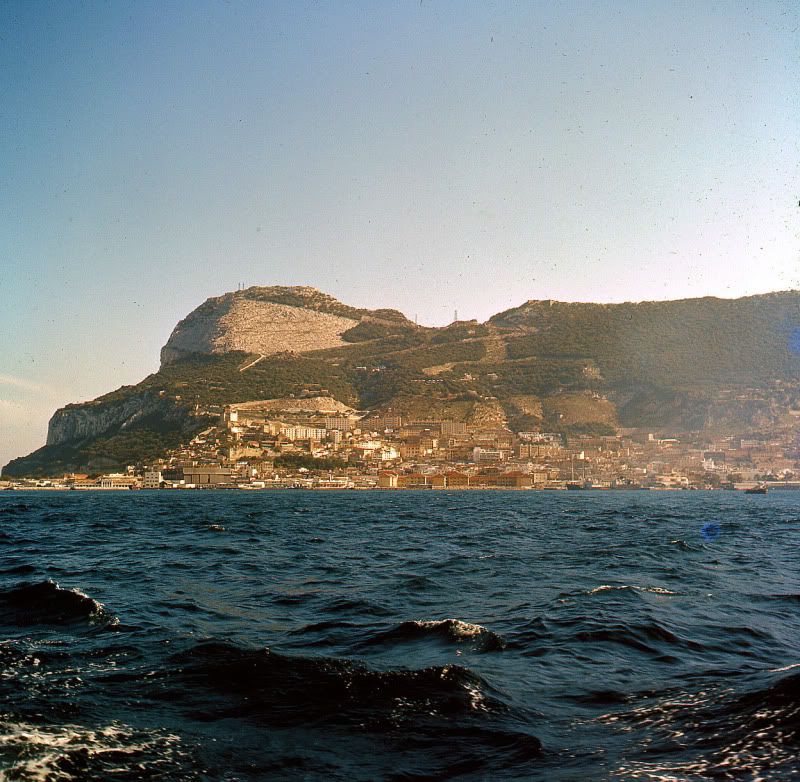
Approaching Gibraltar
Having docked at Gibraltar and been allowed ashore for more shopping, we departed for the UK.
The Nevasa docked at Southampton on the morning of the 1st of December 1958, and following the usual inspection by HM Customs in the customs shed at Southampton we joined the special steam-drawn boat train to London Waterloo only to find that there was no heating in the carriages; we had arrived in the middle of an early and particularly cold, cold spell and the steam heating of the carriages had frozen, leaving us with a two hour journey to Waterloo in a freezing cold train.
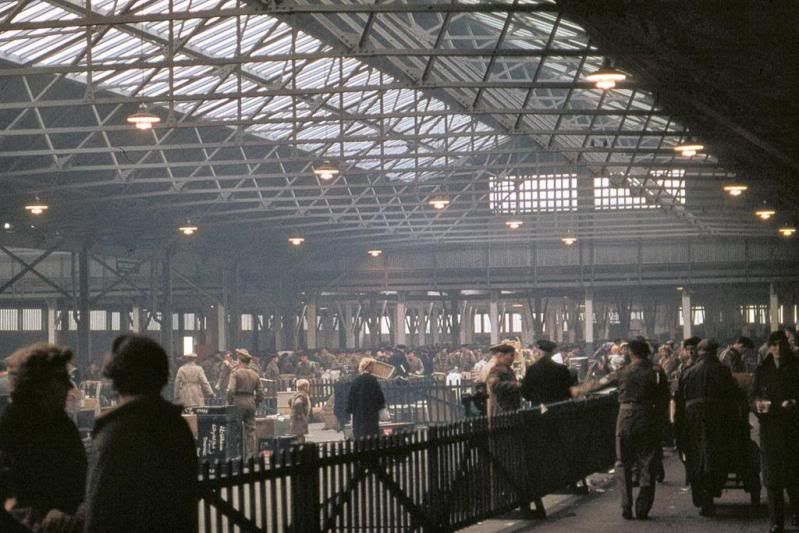
The Customs Shed at Southampton
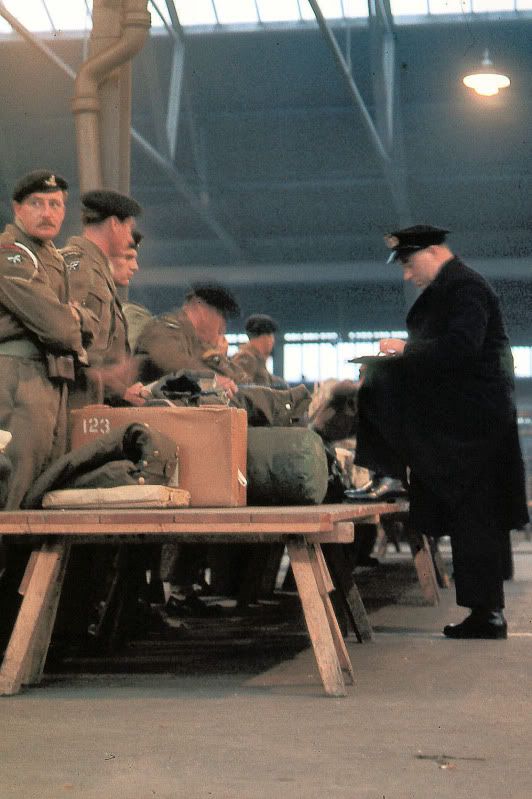
"Anything to declare sir?"
Finally around mid-day I was met at Waterloo by my family and had a short spell of leave before my next posting to RAF Abingdon near Oxford — but that’s another story.
Almost two years later to the day, on the 12th of November 1958 to be exact, I departed from my final FEAF posting (RAF Gan in the Maldive Islands) having earlier during my Far East tour been stationed at Negombo, China Bay, Seletar and finally Gan, I flew from Gan to RAF Katunayake near Colombo in Sri Lanka to join the Nevasa (again!) for my return to the UK.

Tour Ex - The best part of any posting - departing Gan.

On the way to Katunayake we passed over Colombo harbour. The Nevasa, the large white vessel can be seen at anchor in the harbour.

The next day on the 13th of November 1958 I embarked on the Nevasa for the return voyage to the UK. Here Waiting in Colombo harbour for the ferry to the Nevasa that can be seen in the background.

Here's the Nevasa in all her glory.

Departing Colombo Harbour en-route to our next stop - Aden.
We called at Aden and had a day ashore for duty-free shopping (I bought one of the newly introduced transistor radios very cheaply).

This view of Steamer Point shows the RN shore base at Aden (HMS Sheba) low building extreme left alongside the waterfront with the Crescent Hotel immdiately behind it.

Our passage to Port Suez was easy and calm.
We sailed though the Suez Canal viewing the wrecks of ships sunk during the crisis two years earlier and we dropped anchor at Port Suez for a very short stop. We weren’t allowed ashore here but the bum-boats that swarmed around the ship did a brisk business in Egyptian trinkets and souvenirs. Following this short stop we were on our way again to our next stop in Gibraltar, our final stop on the way home, where we were allowed ashore again.
Some Memories
I have some memories of the trip home; the comfort level of the ship was improved in that the bunks were in tiers of three rather than the four that we endured on the way out. But the rest of the voyage was very similar to the journey out, PT on deck, team games and rifle shooting at balloons, more films in the evenings, most of which we’d all seen months earlier. The dining arrangements were similar to the journey out, but this time only with two sittings for meals rather than three. Thankfully we didn’t run out of beer on the way home, which was a relief.
Noteworthy was the sudden overnight change from the warmth of the Red Sea to the chill of the desert as we travelled north up the Red Sea. With the arrival of the cooler weather we were told to change from our tropical KD uniforms into standard UK uniforms. This caused a few problems as most of us hadn’t worn these for two years or so. Like many, my uniform had been sealed up in a waterproof bag shortly after my arrival in the Far East supposedly to stop it being affected by the high humidity, but in my case something had gone seriously wrong because when opened the uniform had gone mouldy – thankfully there was an Indian tailor among the ship’s crew who knew exactly how to deal with this problem (from experience perhaps?) and he passed it back to me, minus the mould, but stinking to high heaven — this musty odour remained with me for the rest of the voyage!
With my newly acquired transistor radio to play with as we travelled north up the Red Sea we searched the wave-bands for English broadcast stations and sure enough we started to receive the BBC relay station in the Middle East relaying the BBC World Service. Memorably the current hit, the Italian song ‘Volare’ which had featured in that year’s Eurovision Song contest was being played regularly. Whenever I hear it played today the catchy tune brings back memories of the Nevasa plying its way along the balmy Red Sea towards ‘Blighty’.
Leaving Port Suez we entered the Mediterranean. The passage to our final stop at Gibraltar was notably rough. I was under the impression that the Mediterranean was a calm and blue sea, but in late November 1958 my assumptions were proved very wide of the mark — it was really rough!

Approaching Gibraltar
Having docked at Gibraltar and been allowed ashore for more shopping, we departed for the UK.
The Nevasa docked at Southampton on the morning of the 1st of December 1958, and following the usual inspection by HM Customs in the customs shed at Southampton we joined the special steam-drawn boat train to London Waterloo only to find that there was no heating in the carriages; we had arrived in the middle of an early and particularly cold, cold spell and the steam heating of the carriages had frozen, leaving us with a two hour journey to Waterloo in a freezing cold train.

The Customs Shed at Southampton

"Anything to declare sir?"
Finally around mid-day I was met at Waterloo by my family and had a short spell of leave before my next posting to RAF Abingdon near Oxford — but that’s another story.
Last edited by Warmtoast; 22nd Jun 2011 at 20:02.
Thread Starter
By Troopship to the Far East - Part 3
By Troopship to the Far East - Part 3
Durban's Lady in White
I refer to the Lady in White in Part 1 (above). Here's some more about her.
Durban’s Lady in White is perhaps one of South Africa's most well known figures of the Second World War. The Lady in White, Mrs Perla Siedle Gibson became a well known figure to Allied troops at Durban harbour, which was South Africa’s busiest port during the war. Mrs Gibson was the daughter of a wealthy South African ship owner and studied as a young woman in Germany to be a soprano. She went on to give recitals in London and Manhattan.
Once described by Perla as her “wharfside work”, it began one day as she was seeing off a young Irish seaman who had been entertained by her family the day before. As his ship was departing, he shouted at her across the water, “Please sing something Irish.” She cupped her hands and started reciting the song, ‘When Irish Eyes are Smiling’. Throughout the years which followed she went on to sing to more than five thousand ships carrying an estimated quarter of a million Allied servicemen in total.

Perla Siedle would often stand at the harbour dressed in her trademark white dress and hat singing to the passing ships with the aid of a megaphone which came from a torpedoed liner as a gift from grateful English troops. Americans would often request that she sing such songs as ‘God Bless America’ and ‘The Star-Spangled Banner’.
English troops often asked for ‘There’ll Always Be an England’, while Australians preferred her performances of ‘Waltzing Matilda’, and South Africans always requested their own national folk songs like ‘Sarie Marais’. Czechs, Poles and Greeks chose opera arias.
Soldier’s talk eventually led to The Lady in White’s fame spreading across the world, and ship captains would salute her as they were passing her. Perla Siedle was even known to U.S. soldiers as Kate Smith or Ma, to Britons as the Lady in White or the Soldiers’ Sweetheart, and to the Poles as the South African Nightingale. Perla Siedle was married to Air Sergeant Jack Gibson, last stationed at Foggia, Italy, and also had two sons and one daughter in the South African Army. She had sung goodbye to all of them, watching their ships move out of sight over the bar to the tune of her favourite closing number, ‘Auld Lang Syne’. Even after the loss of one of her own sons, she refused to stop singing to the troops.
Mrs Gibson died in 1971, a shortly before her 83rd birthday, and a stone cairn with a bronze plaque was erected on Durban’s North Pier in June 1972. The memorial was erected on the site where she would have stood, singing to “her boys”.

Stone cairn with a bronze plaque erected in her honour on Durban’s North Pier near where I photographed her in October 1956. Below

It was donated by the men of the Royal Navy and reads:
“To the memory of Perla Gibson “The Lady In White” who sang to countless thousands of British commonwealth and Allied Servicemen as they passed through Durban over the years 1940 to 1971 This tablet was presented by the Officers and Men of the Royal Navy.”
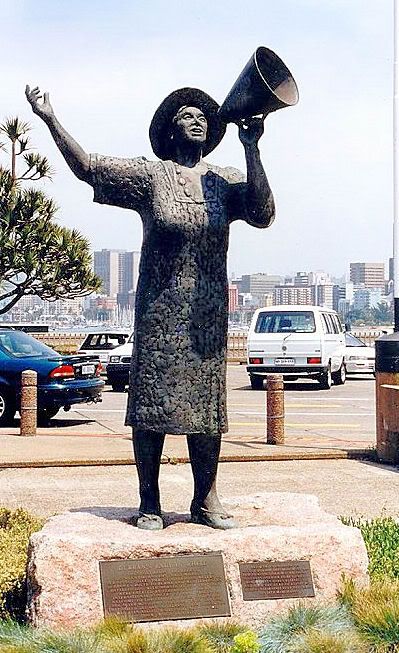
In 1995 a statue of Perla was unveiled by Queen Elizabeth II and today it stands in a prominent place next to the Emtateni Centre, which is part of the Ocean Terminal Building on the Durban Harbour’s T-Jetty. The Perla Siedle Gibson Mobile Library was also founded to serve British seamen and a five room unit at the Highway Hospice was created with funds raised in her memory. The boarding establishment at Glenwood High School was named Gibson House after Perla’s son Roy and its colour is white in her honour.
Durban's Lady in White
I refer to the Lady in White in Part 1 (above). Here's some more about her.
Durban’s Lady in White is perhaps one of South Africa's most well known figures of the Second World War. The Lady in White, Mrs Perla Siedle Gibson became a well known figure to Allied troops at Durban harbour, which was South Africa’s busiest port during the war. Mrs Gibson was the daughter of a wealthy South African ship owner and studied as a young woman in Germany to be a soprano. She went on to give recitals in London and Manhattan.
Once described by Perla as her “wharfside work”, it began one day as she was seeing off a young Irish seaman who had been entertained by her family the day before. As his ship was departing, he shouted at her across the water, “Please sing something Irish.” She cupped her hands and started reciting the song, ‘When Irish Eyes are Smiling’. Throughout the years which followed she went on to sing to more than five thousand ships carrying an estimated quarter of a million Allied servicemen in total.

Perla Siedle would often stand at the harbour dressed in her trademark white dress and hat singing to the passing ships with the aid of a megaphone which came from a torpedoed liner as a gift from grateful English troops. Americans would often request that she sing such songs as ‘God Bless America’ and ‘The Star-Spangled Banner’.
English troops often asked for ‘There’ll Always Be an England’, while Australians preferred her performances of ‘Waltzing Matilda’, and South Africans always requested their own national folk songs like ‘Sarie Marais’. Czechs, Poles and Greeks chose opera arias.
Soldier’s talk eventually led to The Lady in White’s fame spreading across the world, and ship captains would salute her as they were passing her. Perla Siedle was even known to U.S. soldiers as Kate Smith or Ma, to Britons as the Lady in White or the Soldiers’ Sweetheart, and to the Poles as the South African Nightingale. Perla Siedle was married to Air Sergeant Jack Gibson, last stationed at Foggia, Italy, and also had two sons and one daughter in the South African Army. She had sung goodbye to all of them, watching their ships move out of sight over the bar to the tune of her favourite closing number, ‘Auld Lang Syne’. Even after the loss of one of her own sons, she refused to stop singing to the troops.
Mrs Gibson died in 1971, a shortly before her 83rd birthday, and a stone cairn with a bronze plaque was erected on Durban’s North Pier in June 1972. The memorial was erected on the site where she would have stood, singing to “her boys”.

Stone cairn with a bronze plaque erected in her honour on Durban’s North Pier near where I photographed her in October 1956. Below

It was donated by the men of the Royal Navy and reads:
“To the memory of Perla Gibson “The Lady In White” who sang to countless thousands of British commonwealth and Allied Servicemen as they passed through Durban over the years 1940 to 1971 This tablet was presented by the Officers and Men of the Royal Navy.”

In 1995 a statue of Perla was unveiled by Queen Elizabeth II and today it stands in a prominent place next to the Emtateni Centre, which is part of the Ocean Terminal Building on the Durban Harbour’s T-Jetty. The Perla Siedle Gibson Mobile Library was also founded to serve British seamen and a five room unit at the Highway Hospice was created with funds raised in her memory. The boarding establishment at Glenwood High School was named Gibson House after Perla’s son Roy and its colour is white in her honour.
Last edited by Warmtoast; 23rd Jun 2011 at 05:31.
Join Date: Mar 2000
Location: Sunrise Senior Living
Posts: 1,338
Likes: 0
Received 0 Likes
on
0 Posts
It's a small world! I went to HK in 1957 as a 10yr old schoolboy on board the 'Nevasa' (British India Steam Navigation Company - Captain Bond) and came back a couple of years later on the 'Oxfordshire' (Bibby Line - Captain Fitch). 4 weeks each way calling at Singapore, Colombo, Aden, Malta and Gibraltar. My father was in the RN and we went out there as a family.
As you say, Warmtoast, 'What a way to go - and come back!'
As you say, Warmtoast, 'What a way to go - and come back!'
Excellent post, Warmtoast!
That photo of the disembarkation area at Southampton brings back distant boyhood memories! In the late 1950s, a friend of my late father was well-connected at Southampton and he invited us for a conducted tour. So, at some early hour with my brother and I dressed up (as one did in those days) in grey flannel suits with short trousers, we set off in the family Mk 1 Zephyr convertible for the long drive from Somerset to Southampton (well, it seemed pretty long - it was about 90 miles on single carriageway roads!).
After arrival at Southampton we were shown some rather sorry-looking flying boats on Southampton Water, then had a fascinating tour of the RMS Queen Mary. I remember being astonished that it actually had a swimming pool. After the Mary, we drove past the Queen Elizabeth in dry dock and went to the Ocean Terminal to watch the arrival and disembarkation of a troop ship - it could even have been the Nevasa! Our host said "Watch this - the sausage machine in action!". A sea of khaki-clad men with kit bags poured down the gangways out of the ship and were rapidly processed before boarding the 'Boat Train', which then chuffed its merry way to London.
Back into the Zephyr; then the long drive home... I'm so glad now that I can just remember those days of ocean steamers, steam trains, lots of military jets....and the last of the flying boats! I think it must have been late 1956 as the troops we'd seen were 'coming home from Suez'.
That photo of the disembarkation area at Southampton brings back distant boyhood memories! In the late 1950s, a friend of my late father was well-connected at Southampton and he invited us for a conducted tour. So, at some early hour with my brother and I dressed up (as one did in those days) in grey flannel suits with short trousers, we set off in the family Mk 1 Zephyr convertible for the long drive from Somerset to Southampton (well, it seemed pretty long - it was about 90 miles on single carriageway roads!).
After arrival at Southampton we were shown some rather sorry-looking flying boats on Southampton Water, then had a fascinating tour of the RMS Queen Mary. I remember being astonished that it actually had a swimming pool. After the Mary, we drove past the Queen Elizabeth in dry dock and went to the Ocean Terminal to watch the arrival and disembarkation of a troop ship - it could even have been the Nevasa! Our host said "Watch this - the sausage machine in action!". A sea of khaki-clad men with kit bags poured down the gangways out of the ship and were rapidly processed before boarding the 'Boat Train', which then chuffed its merry way to London.
Back into the Zephyr; then the long drive home... I'm so glad now that I can just remember those days of ocean steamers, steam trains, lots of military jets....and the last of the flying boats! I think it must have been late 1956 as the troops we'd seen were 'coming home from Suez'.
Cor, what an interesting post. When Pa was posted to Malta from Leuchars in 1959 we sailed out from Southampton on the good ship "Devonshire". We came back in 1962 to Gatwick - thence to North Weald - on an Eagle Airways DC-6.
When trooping by sea was discontinued the Nevasa became a schools cruise ship taking school children on "educational" cruises in the 1960's and 70's.
I believe the last schools cruise ship was the Uganda which was requisitioned for the Falklands Campaign as a hospital ship.
I believe the last schools cruise ship was the Uganda which was requisitioned for the Falklands Campaign as a hospital ship.
Very interesting post. I went to Singapore and back on both ships as a service brat. My father was posted to Tengah as a GCA controller (RAF). I cannot remember which one, I think the Oxfordshire, was subsequently sold to the 'Sitmar Line', modified with an extra deck and renamed the "Fairsky". I then migrated to Australia on it in August 1964. Those photos bring back many memories. Thanks for posting.
Brilliant post and photos. As Warmtoast says, she became a schools cruise liner. I don't think B & I bothered with much of a refurbishment. I went on her in c 1965, my main memory is of prone schoolkids in every corridor as we crossed the Bay of Biscay, when I went out for some fresh air cascades of puke appeared from the decks above! And the scoff was fairly rank too....
Join Date: Aug 2007
Location: uk
Age: 69
Posts: 9
Likes: 0
Received 0 Likes
on
0 Posts
those pictures!
Have to put my two pennies worth in! Paxed out to Singapore 010159 on the regular trooper, namely an Airwork Hermes with 8 stops but returned in "luxury" in Oxfordshire 310861. As my Dad was an RAF officer (and paymaster for the airmen on board) we had a cabin. I remember the salt water showers though. Whilst in Singapore we went up to Hong Kong on the Nevassa on R&R. I believe she did a small refit whilst there at the Whampoa dockyards. Those wonderful pictures have unlocked distant memories of those times, although I wished I'd snapped the scene of an Arab trying (and succeeding) to stuff a pouffe into our porthole whilst balancing on the top of his mast in Port Said!
Join Date: Jul 2001
Location: Ottawa, Canada
Age: 70
Posts: 213
Likes: 0
Received 0 Likes
on
0 Posts
Interesting Post, as an 11yr old we had a school trip that went on a tour of the Holy Land over Christmas 1964 on the Nevassa! The boat had a "passenger" section up front and the blunt end was a floating school. The two sections were well separated to keep the school kids out of the "posh" area. It seems the accommodation hadn't changed much from the troopship days with three tiered bunks.
We flew on a BCAL Brit to Venice, then by sea to Athens, Beirut, Haifa, Gib and back to Southampton. Great trip, but wish I had done it a few years later when I had a better appreciation of girls!!
ex-egll
We flew on a BCAL Brit to Venice, then by sea to Athens, Beirut, Haifa, Gib and back to Southampton. Great trip, but wish I had done it a few years later when I had a better appreciation of girls!!
ex-egll
Thread Starter
NotGettingAnyYounger
Dakar Harbour
Thanks for this. I'll bow to the experts opinion and have replaced the photo in question.
WT
Dakar Harbour
I am reliably informed that the white vessel in the Dakar harbour photograph is flying an Indonesian flag with a red duster as courtesy flag. This suggests that photograph was taken in Singapore and not Dakar.
Update: members of the Ships Nostalgia web site are suggesting that the photograph is of the Inner Anchorage at Singapore and could well have been taken from Clifford Pier.
Update: members of the Ships Nostalgia web site are suggesting that the photograph is of the Inner Anchorage at Singapore and could well have been taken from Clifford Pier.
WT




